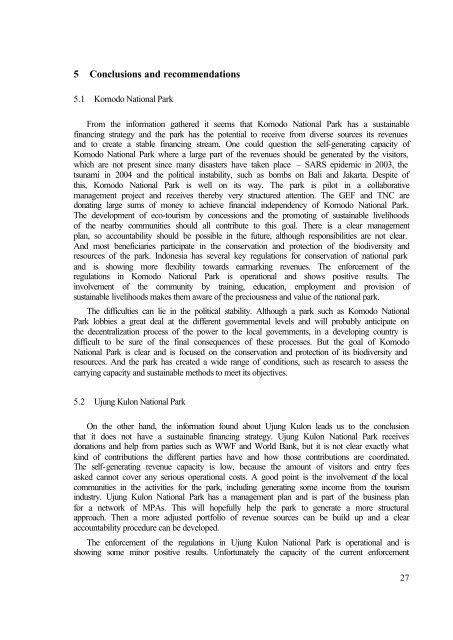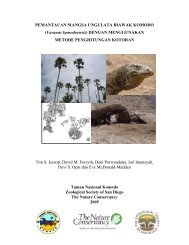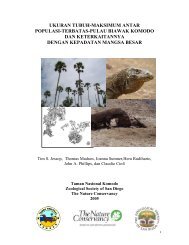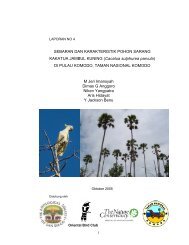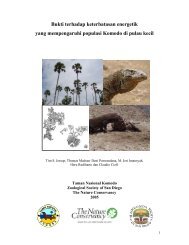Sustainable Financing of MPAs - Komodo National Park
Sustainable Financing of MPAs - Komodo National Park
Sustainable Financing of MPAs - Komodo National Park
Create successful ePaper yourself
Turn your PDF publications into a flip-book with our unique Google optimized e-Paper software.
5 Conclusions and recommendations<br />
5.1 <strong>Komodo</strong> <strong>National</strong> <strong>Park</strong><br />
From the information gathered it seems that <strong>Komodo</strong> <strong>National</strong> <strong>Park</strong> has a sustainable<br />
financing strategy and the park has the potential to receive from diverse sources its revenues<br />
and to create a stable financing stream. One could question the self-generating capacity <strong>of</strong><br />
<strong>Komodo</strong> <strong>National</strong> <strong>Park</strong> where a large part <strong>of</strong> the revenues should be generated by the visitors,<br />
which are not present since many disasters have taken place – SARS epidemic in 2003, the<br />
tsunami in 2004 and the political instability, such as bombs on Bali and Jakarta. Despite <strong>of</strong><br />
this, <strong>Komodo</strong> <strong>National</strong> <strong>Park</strong> is well on its way. The park is pilot in a collaborative<br />
management project and receives thereby very structured attention. The GEF and TNC are<br />
donating large sums <strong>of</strong> money to achieve financial independency <strong>of</strong> <strong>Komodo</strong> <strong>National</strong> <strong>Park</strong>.<br />
The development <strong>of</strong> eco-tourism by concessions and the promoting <strong>of</strong> sustainable livelihoods<br />
<strong>of</strong> the nearby communities should all contribute to this goal. There is a clear management<br />
plan, so accountability should be possible in the future, although responsibilities are not clear.<br />
And most beneficiaries participate in the conservation and protection <strong>of</strong> the biodiversity and<br />
resources <strong>of</strong> the park. Indonesia has several key regulations for conservation <strong>of</strong> national park<br />
and is showing more flexibility towards earmarking revenues. The enforcement <strong>of</strong> the<br />
regulations in <strong>Komodo</strong> <strong>National</strong> <strong>Park</strong> is operational and shows positive results. The<br />
involvement <strong>of</strong> the community by training, education, employment and provision <strong>of</strong><br />
sustainable livelihoods makes them aware <strong>of</strong> the preciousness and value <strong>of</strong> the national park.<br />
The difficulties can lie in the political stability. Although a park such as <strong>Komodo</strong> <strong>National</strong><br />
<strong>Park</strong> lobbies a great deal at the different governmental levels and will probably anticipate on<br />
the decentralization process <strong>of</strong> the power to the local governments, in a developing country is<br />
difficult to be sure <strong>of</strong> the final consequences <strong>of</strong> these processes. But the goal <strong>of</strong> <strong>Komodo</strong><br />
<strong>National</strong> <strong>Park</strong> is clear and is focused on the conservation and protection <strong>of</strong> its biodiversity and<br />
resources. And the park has created a wide range <strong>of</strong> conditions, such as research to assess the<br />
carrying capacity and sustainable methods to meet its objectives.<br />
5.2 Ujung Kulon <strong>National</strong> <strong>Park</strong><br />
On the other hand, the information found about Ujung Kulon leads us to the conclusion<br />
that it does not have a sustainable financing strategy. Ujung Kulon <strong>National</strong> <strong>Park</strong> receives<br />
donations and help from parties such as WWF and World Bank, but it is not clear exactly what<br />
kind <strong>of</strong> contributions the different parties have and how those contributions are coordinated.<br />
The self-generating revenue capacity is low, because the amount <strong>of</strong> visitors and entry fees<br />
asked cannot cover any serious operational costs. A good point is the involvement <strong>of</strong> the local<br />
communities in the activities for the park, including generating some income from the tourism<br />
industry. Ujung Kulon <strong>National</strong> <strong>Park</strong> has a management plan and is part <strong>of</strong> the business plan<br />
for a network <strong>of</strong> <strong>MPAs</strong>. This will hopefully help the park to generate a more structural<br />
approach. Then a more adjusted portfolio <strong>of</strong> revenue sources can be build up and a clear<br />
accountability procedure can be developed.<br />
The enforcement <strong>of</strong> the regulations in Ujung Kulon <strong>National</strong> <strong>Park</strong> is operational and is<br />
showing some minor positive results. Unfortunately the capacity <strong>of</strong> the current enforcement<br />
27


